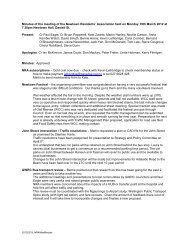Draft Town Belt Management Plan - Wellington City Council
Draft Town Belt Management Plan - Wellington City Council
Draft Town Belt Management Plan - Wellington City Council
Create successful ePaper yourself
Turn your PDF publications into a flip-book with our unique Google optimized e-Paper software.
“It is indeed desirable that the whole outside of the <strong>Town</strong>, inland, should be separated<br />
from the country by a broad belt of land which you will declare that the Company intends<br />
to be public property on condition that no buildings be ever erected upon it" 89 .<br />
The objects of the <strong>Town</strong> <strong>Belt</strong>, as well as separating the town and country, were, Ward explained in his<br />
letter, “... to supply space for recreation and common to the public ...”. He also stated that the company<br />
directors “... wish the public convenience to be consulted and the beautiful appearance of the city to be<br />
secured ... rather than the immediate profit of the company ...” 90 .<br />
Following New Zealand Company land purchase negotiations with the Māori of Pito-one and Nga-iiranga<br />
under the Port Nicholson deed of September 1839, the first immigrants arrived in January 1840<br />
and established a settlement called Britannia at Petone, near the mouth of the Hutt River. They soon<br />
discovered that the flood-prone site was "quite unfit for a town" so, in March, New Zealand Company<br />
representative Colonel Wakefield moved the settlement to the shores of Lambton Harbour, even though<br />
the Māori communities of Te Aro, Kumototo and Pipitea, who lived there, had not been party to the<br />
earlier land purchases.<br />
Captain Mein Smith finalised the plan for the new settlement of <strong>Wellington</strong> in August 1840. The extent<br />
of the <strong>Town</strong> <strong>Belt</strong> was shown and marked as “land around the <strong>Town</strong> reserved for the enjoyment of the<br />
Public and not to be built upon”.<br />
Crown and provincial government, 1841–1873<br />
In 1841 the Crown assumed ownership of the <strong>Town</strong> <strong>Belt</strong> area (approximately 625ha) and proclaimed the<br />
land a public reserve. The Waitangi Tribunal later found that the earlier Port Nicholson land purchases<br />
had been invalid and the taking of reserves in <strong>Wellington</strong> prejudicial to Māori (see Appendix 3).<br />
Governor Hobson directed that a notice be published in the Government Gazette requiring anyone<br />
occupying public or native reserves to vacate those sites, and declaring that "all persons are warned not<br />
to clear, fence, cultivate or build in or upon any portion of the belt of reserved land surrounding the<br />
town" 91 .<br />
In 1862, the <strong>Town</strong> <strong>Belt</strong>’s management was vested in the newly formed <strong>Wellington</strong> <strong>Town</strong> Board 92 and an<br />
Act 93 passed that allowed for carriage roads and footpaths across the <strong>Town</strong> <strong>Belt</strong>, the leasing of allotment<br />
areas for up to 14 years, and the laying out, planting and enclosure of public areas, including for<br />
recreation.<br />
During the period of Crown and provincial government, approximately one-third (193 ha) of the <strong>Town</strong><br />
<strong>Belt</strong> area was taken for other purposes including land returned to Māori (see Appendix 3)<br />
Civic government, 1871–present<br />
Under the <strong>Wellington</strong> <strong>City</strong> Reserves Act 1871, the Superintendent of the Province of <strong>Wellington</strong> was<br />
instructed to convey the <strong>Town</strong> <strong>Belt</strong> from the Crown to the <strong>City</strong> of <strong>Wellington</strong> (made a borough in 1870). The<br />
Act stipulated that one half of revenue derived from the land was to be "devoted to the ornamentation and<br />
utilisation of the lands ... and ... the other half ... to the construction and maintenance of roads upon the<br />
<strong>Town</strong> <strong>Belt</strong> ... connecting the streets of the said city with the country roads”. In 1872, before the land was<br />
transferred in Trust the <strong>Wellington</strong> <strong>City</strong> Reserves Act 1872 authorised the Superintendent to appropriate<br />
21.85 ha (143 acres) of <strong>Town</strong> <strong>Belt</strong> in Newtown for education and social welfare purposes (see section four).<br />
89 Ward to Smith. Quoted in Walter Cook, “Background Report 3, European History,” <strong>Wellington</strong> <strong>Town</strong> <strong>Belt</strong><br />
<strong>Management</strong> <strong>Plan</strong> Review. (<strong>Wellington</strong>: <strong>Wellington</strong> <strong>City</strong> <strong>Council</strong>, 1992).<br />
90 Follows<br />
91 New Zealand Government Gazette 1841, P. 80, 16 October 1841. Quoted in Cook, “Background Report 3”.<br />
92 The Board was formed under the <strong>Wellington</strong> <strong>Town</strong> Board Act 1862, following the Public Reserves Amendment Act<br />
1862, which enabled the control of public reserves to be transferred or vested to commissioners or other persons, to be<br />
held in trust for similar or specified public purposes.<br />
93 <strong>Management</strong> of <strong>City</strong> Reserves Act 1862.<br />
<strong>Draft</strong> <strong>Town</strong> <strong>Belt</strong> <strong>Management</strong> <strong>Plan</strong> October 2012<br />
207





